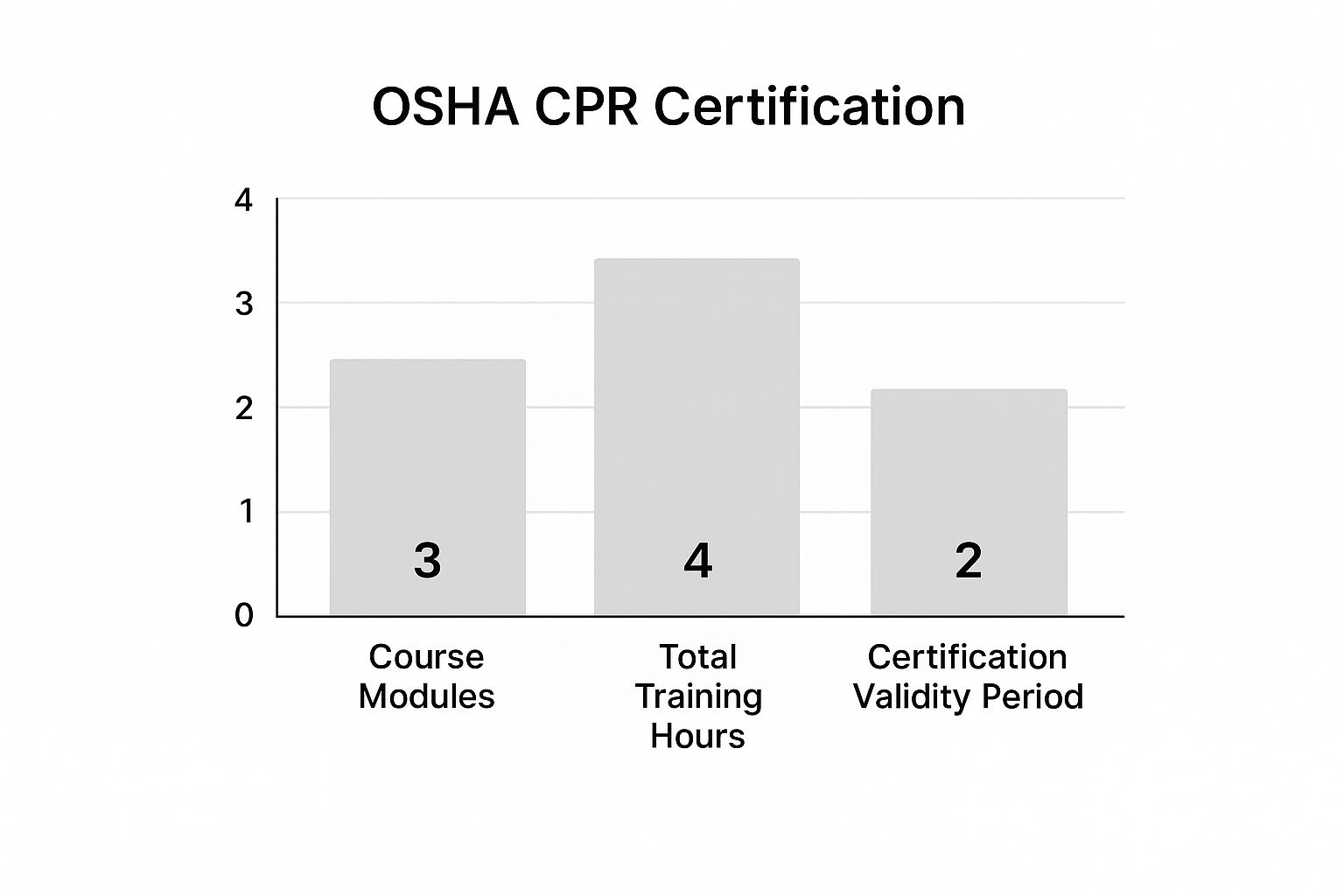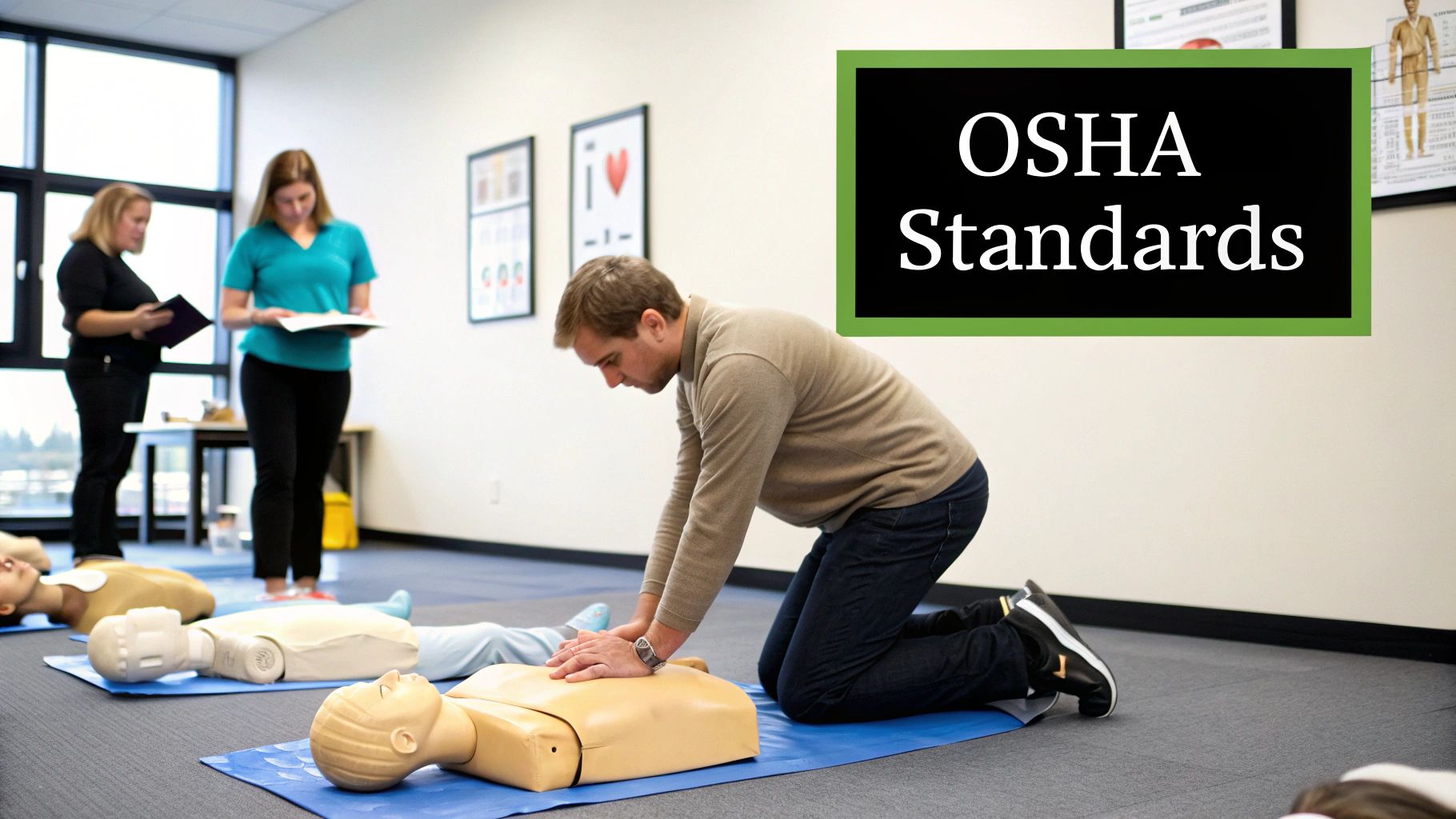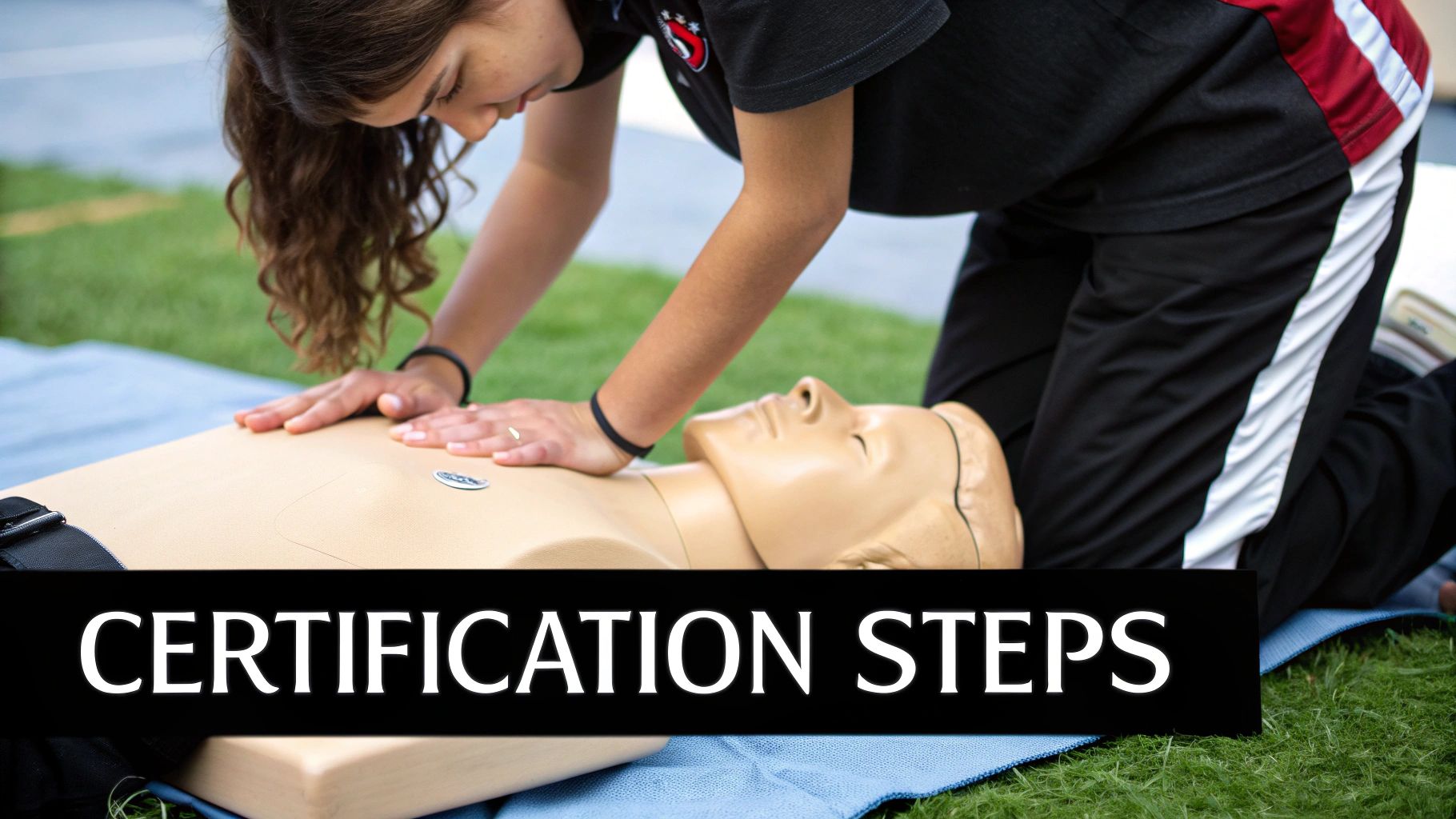When you hear "OSHA," your mind probably jumps to hard hats and safety harnesses. But did you know one of their most critical requirements is all about what happens when things go wrong? I'm talking about CPR and first aid training.
The core idea is pretty simple. If your workplace isn't just a stone's throw away from a hospital or clinic, OSHA says you can't just cross your fingers and hope for the best. You need people on your team who can step in and provide immediate, life-saving care during an emergency. It's less about bureaucratic red tape and more about having a human fire extinguisher ready to go.
Understanding OSHA's Core CPR Requirements
At its heart, OSHA's rule on this is about one thing: protecting your people.
The specific regulation, 29 CFR 1910.151, makes it the employer's job to ensure medical help is available—and fast. When an ambulance is more than a few minutes away, that responsibility shifts to trained individuals right there on the job site. This isn't just about checking a box on a compliance form. It's about being genuinely prepared for the worst-case scenario. Accidents are, by their nature, unexpected. Having a CPR-certified person on hand can literally be the difference between a close call and a tragedy.
This is the bedrock of a truly safe work environment.
The Proximity Rule: How Close is "Close"?
So, what does OSHA consider "close proximity" to a medical facility? While they don't give a hard-and-fast number in miles, the generally accepted guideline is about 3-4 minutes. If it would take longer than that for an ambulance or professional medical help to arrive, you're required to have a trained first-aid provider on site.
To make it crystal clear, here’s a simple breakdown of how the proximity rule works in practice.
OSHA First Aid and CPR Proximity Rule at a Glance
This table really puts the employer's responsibility into perspective. It's a clear, straightforward requirement based entirely on how quickly your team can get professional help.

As the infographic shows, a typical, compliant certification course takes about four hours and is valid for two years. This isn't just a quick video and a quiz; it’s a structured program designed to build real skills and confidence. The training is broken down into modules covering CPR, AED use, and first aid, ensuring your people are truly prepared.
Key Takeaway: OSHA’s rules are less about rigid definitions and more about practical outcomes. The goal is to bridge the gap between when an incident occurs and when professional medical help arrives. A trained employee is that bridge.
Ultimately, understanding these foundational requirements is the first step toward building a safer workplace. It shifts the focus from simple compliance to cultivating a culture of preparedness, where every team member feels secure knowing that help is immediately available if the worst should happen. This proactive approach is the true spirit of OSHA's lifesaving mandate.
Which Industries and Roles Need CPR Training

While the "nearby hospital" rule is a good starting point, OSHA gets much more specific for certain fields. Some jobs are just inherently riskier, and for them, CPR training isn't optional—it's a non-negotiable part of the safety plan. It’s less about how close you are to an ER and more about the unique dangers baked into the work itself.
This isn’t a friendly suggestion from OSHA. It’s a direct requirement tied to clear and present hazards on the job. Let’s get past the general advice and pinpoint exactly who needs this training and, more importantly, why.
High-Risk Industries And Specific Roles
OSHA doesn't just paint with a broad brush here. It targets specific roles where a medical emergency is statistically more likely to happen and where a few minutes can make all the difference. The thinking is simple: higher risk demands a higher level of preparation.
Here are a few of the key jobs that have specific OSHA CPR certification requirements:
- Electrical Workers (1910.269): Anyone working on or near high-voltage equipment faces the ever-present danger of electric shock, which can instantly stop a heart. For these pros, CPR isn't just a "nice to have"—it's a direct countermeasure to one of their biggest occupational risks.
- Logging Operations (1910.266): Logging is consistently one of the most dangerous jobs in the country. Crews are often deep in remote, rugged areas, miles from the nearest medical help. After an accident, a trained coworker is often the only lifeline.
- Confined Space Entry Teams (1910.146): When your job involves entering tanks, vaults, or other tight spaces, you're walking into environments where oxygen can be low or toxic gases can be high. Both can cause someone to collapse in an instant. A trained attendant waiting outside must be ready to start a rescue and perform CPR immediately.
- Hazardous Waste Operations (1910.120): People who handle hazardous materials are at risk of chemical exposures that can cause sudden respiratory or cardiac arrest. Having CPR-certified staff on hand is absolutely critical for managing these high-stakes incidents.
In every one of these examples, the why is crystal clear. The training is directly linked to the specific dangers of the job, making it a cornerstone of the entire safety protocol.
Who Is A Designated First-Aid Responder?
Beyond those industry-specific rules, many companies are required to appoint what OSHA calls a designated first-aid responder. This isn’t just the person who volunteers to keep the first-aid kit stocked. It's a formal, assigned role with real-world responsibilities.
A designated responder is an employee who has been officially tasked by the company to provide first aid as part of their job. That formal designation is the key. It means the company is officially relying on this person to step up and act correctly in an emergency.
Key Insight: Simply having an employee with a CPR card on payroll isn't enough to satisfy OSHA if they haven't been formally designated. The employer is responsible for making sure these responders are available, their training is current, and they're ready to act across all shifts and work areas.
Identifying these people is one of the first steps in building a truly compliant safety program. You have to ask the right questions:
- Who is our point person on the day shift?
- Do we have a trained responder for our night crew?
- Is someone available on weekends or in the back warehouse?
Answering these helps you shift from just hoping someone can help to strategically ensuring someone is always ready. Recognizing the need for CPR training in the workplace is about creating a deliberate, reliable safety net for your entire team. It's an active strategy, not a passive hope—and that proactive mindset is what truly protects your people.
What Makes a CPR Course OSHA Compliant?
Not every CPR course you find online or in your community will pass muster with OSHA. The agency is particular about its requirements, and for good reason—when a life is on the line, the quality of your training is what really matters. Just having a certificate isn't enough; the course itself must cover specific topics and, most importantly, include a hands-on skills session.
Think of it like learning to drive. You can read the driver's manual from cover to cover and ace the written test, but that doesn't mean you're ready for the highway. You need time behind the wheel with an instructor. OSHA looks at CPR training the exact same way. Theory is just the first step.
The Critical Hands-On Skills Requirement
This is the single biggest hurdle that separates a compliant course from one that isn't. OSHA is crystal clear: CPR and first aid training must include a physical practice component where students prove they can perform the skills. This is precisely why a 100% online CPR course will almost never meet OSHA CPR certification requirements.
A proper skills evaluation has to involve:
- Practicing on a Mannequin: Students must perform chest compressions and rescue breaths on a CPR mannequin. This is where you build the muscle memory for the right rate, depth, and hand placement.
- Instructor Feedback: A certified instructor watches you, offers real-time corrections, and confirms you can perform the skills correctly, even under a little pressure.
- AED Practice: Training has to include hands-on practice with an AED training device, so you know exactly how to apply the pads and follow the machine’s voice prompts without hesitation.
This hands-on portion is completely non-negotiable. It’s what transforms passive knowledge into an active, life-saving ability.
Core Topics Every Compliant Course Must Cover
Beyond the physical practice, the course content itself has to be solid. OSHA expects the curriculum to be built on the latest scientific guidelines from respected organizations like the American Heart Association (AHA).
Any compliant course curriculum will always include:
- Recognizing an Emergency: Teaching students how to spot the signs of cardiac arrest, a heart attack, or choking.
- Activating EMS: Driving home the importance of calling 911 immediately.
- Adult CPR Techniques: Detailed instruction on delivering high-quality chest compressions and effective rescue breaths.
- AED Usage: Comprehensive training on how to use an Automated External Defibrillator safely and efficiently.
While adult CPR is the baseline requirement, many top-tier programs also cover emergencies involving younger victims. Knowing the subtle differences in these situations gives you a more complete skill set, which is why it's so valuable to understand child CPR as well.
The Muscle Memory Test: Imagine two employees. One watched a 30-minute CPR video. The other spent an hour on their knees, practicing compressions on a mannequin until their arms ached, feeling the "click" of a proper compression. When a coworker collapses, who do you think will act with confidence instead of freezing in panic? That's exactly why OSHA insists on the hands-on component.
Renewal Timelines and Staying Current
Skills get rusty. It’s just human nature. Because of this, OSHA requires that your training be kept up-to-date. According to the official OSHA guidelines on training, CPR skills should be refreshed annually. A full first aid recertification is generally required every 2-3 years, depending on the training provider's standards.
Any renewal course worth its salt will blend knowledge review with hands-on practice to make sure your skills stay sharp and effective.
Choosing a course that meets these strict criteria does more than just check a compliance box. It equips your team with genuine, life-saving skills, making sure they're ready to act decisively and correctly when every second counts. It’s an investment in real readiness, not just another certificate for the file.
How to Choose a Reputable CPR Training Provider

Knowing what a compliant course looks like is half the battle; finding the right provider to deliver it is the other. OSHA doesn't “approve” or “certify” specific training companies. Instead, the responsibility falls squarely on you, the employer, to pick a provider whose program checks all the right boxes.
This puts the power in your hands, but it also means you need to do your homework. Choosing the right partner ensures your team gets effective, life-saving training and that your business stays compliant—saving you from potential fines and major headaches down the road.
The Gold Standard Providers
When you start looking at training providers, a few names carry immediate weight. Organizations like the American Heart Association (AHA) and the American Red Cross are the gold standard in the industry. Their programs are universally accepted because their curriculums are built on the latest resuscitation science and serve as the foundation for OSHA's own expectations.
If a provider bases their course on current AHA or Red Cross guidelines, you’re already on the right track. But that doesn't rule out the many excellent local and independent trainers who also offer OSHA-compliant courses. The trick is knowing how to vet them properly. For a deeper look, check out our guide on choosing the right CPR training provider.
A Vetting Checklist for Any Provider
Whether you’re considering a national organization or a local expert, you need to ask the right questions. Any reputable provider will have clear, confident answers for all of these. Use this checklist as your guide to protect both your team and your business.
- Does the certification include a hands-on skills test? This is a deal-breaker. If the answer is anything but a firm "yes," the course will not meet OSHA CPR certification requirements.
- Is the curriculum based on current AHA or Red Cross guidelines? Their scientific standards are the benchmark. A provider should be able to confirm their course material aligns with the latest recommendations.
- Are your instructors certified to teach? Instructors aren't just people who know CPR; they should hold current teaching credentials from a recognized body like the AHA or Red Cross.
- What is the instructor-to-student ratio? You want small class sizes. It’s the only way to get enough individual attention and hands-on practice so that no one gets lost in the crowd.
- Do you offer blended learning options? A quality blended program combines online coursework with an in-person skills session. It offers great flexibility without sacrificing that crucial hands-on component.
Armed with these questions, you can confidently filter out the "check-the-box" programs and focus on those that deliver real, life-saving skills.
Key Insight: Don't be afraid to ask direct questions about hands-on practice and curriculum standards. A trustworthy provider will welcome your diligence, while a questionable one might offer vague or evasive answers. Your employees' safety depends on this scrutiny.
The Advantage of On-Site Group Training
For many businesses, the most effective and efficient solution is to bring a certified instructor directly to your workplace. On-site group training has some clear advantages. It cuts out travel time for your employees and allows them to learn in the exact environment where an emergency might actually happen.
This approach is also highly scalable, whether you need to certify a small team of five or an entire department of fifty. Better yet, it builds a sense of shared responsibility and team spirit as employees learn these critical skills together. It can turn a simple compliance task into a valuable, shared team experience.
Maintaining Certification and Staying Compliant
Earning that initial CPR certificate is a huge accomplishment, but it's really just the starting line. The real work is in keeping those skills sharp and making sure your business stays compliant for the long haul. This isn't about a one-time class; it's about building a solid program that keeps your team truly prepared to act and ready for any audit.
Think of CPR skills like a perishable good. They're freshest right after training but can fade over time without practice. OSHA gets this, which is why they care just as much about ongoing compliance as they do about the first certification.
The Two-Year Renewal Cycle
So, how often does your team need to renew their CPR certification? OSHA doesn't actually stamp a specific date on it in their regulations. Instead, they point back to the standards set by the major training organizations that issue the cards in the first place.
For nearly every recognized provider, including the American Heart Association and the American Red Cross, a standard CPR certification is valid for two years. This has become the accepted industry benchmark. Once that two-year mark passes, a responder is no longer considered "current," and their certification has to be renewed to meet OSHA CPR certification requirements.
Building a Simple Tracking System
An expired certification can create a serious compliance gap before you even realize it. One of the easiest ways for a business to get into trouble is by simply letting a card lapse, leaving a shift without a qualified first responder. The good news is, preventing this is surprisingly simple.
You don't need some complex, expensive software. A great tracking system can be built with tools you probably already have.
- Digital Calendars: Set up a shared calendar for your safety team or HR. For every certified employee, plug in their expiration date and create a few reminders that start popping up 90 days ahead of time.
- Spreadsheets: A basic spreadsheet is perfect for tracking names, certification dates, and expiration dates. You can even use conditional formatting to make rows change color when a renewal is getting close.
- HR Software: If you use a modern HR platform, check to see if it has a module for tracking licenses and certifications. This is often the most streamlined way to handle it.
The key is to be proactive, not reactive. A reliable tracking system transforms renewal from a last-minute scramble into a predictable, routine part of your safety management process.
Managing your team's certifications is a critical task. For a deeper dive into setting up a bulletproof system, you can learn more about employee CPR certification renewal and how to build a program that works.
Staying Audit-Ready with Proper Documentation
If an OSHA compliance officer walks through your door, one of the first things they'll want to see is proof of training. Not being able to produce the right documents is just as bad as not having done the training at all. Keeping clear, organized records isn't just a good idea—it's non-negotiable.
To keep your program audit-ready, you absolutely must maintain a file that includes:
- Copies of Certification Cards: Keep a digital or physical copy of the front and back of every designated responder's current CPR and first-aid card.
- Training Rosters: If you hosted a group class at your facility, always keep the sign-in sheet from the instructor. This is your proof of who was in the room.
- Course Outlines: It’s a great practice to hold onto a copy of the course curriculum. This shows that your team's training covered all the essential topics, especially the hands-on skills practice.
Keeping these records creates a clear paper trail that proves your company's commitment to a safe workplace. It protects your business and, more importantly, ensures your people are always qualified and ready to save a life.
The True Value of a CPR-Ready Workplace

We’ve covered a lot of ground on the rules, regulations, and requirements. Now, let's push the compliance paperwork aside for a moment and talk about what this is really all about: your people. Meeting OSHA CPR certification requirements isn’t the finish line; it’s the starting block for building a workplace where your team is genuinely safe.
A certification card is just a piece of plastic. The real value is in the confidence and skill it represents—the power to step up and save a life when every single second counts.
Beyond Compliance: The Human ROI
The statistics around cardiac arrest are sobering. In the United States, over 350,000 out-of-hospital cardiac arrests happen every year. The single most critical factor in survival isn't how fast an ambulance arrives, but how quickly a bystander takes action. Immediate CPR can double or even triple a person’s chance of survival, yet only about 40% of victims get that help before professionals arrive. You can learn more about these powerful CPR facts from the American Heart Association.
This is where your investment in training pays its biggest dividend. It’s not about preventing fines; it’s about preventing funerals.
Picture this: Dave, a long-time employee, suddenly collapses in the breakroom. Panic begins to ripple through the room. But instead of freezing, Sarah, who just renewed her CPR last month, immediately takes charge. She checks for breathing, tells someone to call 911 and grab the AED, and starts chest compressions without a second thought.
Her hands-on training just kicks in. She doesn't have to stop and think. She keeps going until paramedics arrive to take over. A week later, you get a call from Dave’s family. He made it, they tell you, because of what Sarah did in those first few critical minutes.
That is the true return on your investment. You can’t put a price on that.
A Culture of Safety and Support
When you invest in high-quality, hands-on training, you send a clear message to your team: "We care about you. Your safety is our priority." That's a message that resonates far more deeply than any motivational poster on a wall.
A CPR-ready workplace isn't just a compliant one—it's a compassionate one. It fosters an environment where employees look out for one another, knowing they have the skills to make a difference in a crisis.
This commitment creates ripples throughout your company culture. It builds morale, increases employee loyalty, and fosters a powerful sense of shared responsibility. People feel safer knowing their colleagues are prepared to help, turning a group of coworkers into a truly connected and resilient team.
Ultimately, the goal isn't just to check a box on an OSHA standard. It's about building a place where everyone feels safe and valued. By choosing a partner like Ready Response for your training, you're investing in your people’s well-being and creating a culture of preparedness that protects your most valuable asset: your team.
Got Questions About OSHA CPR Rules? We've Got Answers
Digging into OSHA’s specific rules for CPR can feel like trying to solve a puzzle. It’s totally normal to have questions. Let's walk through some of the most common ones we hear, clearing up the confusion so you can feel confident your team is compliant and prepared.
Is An Online-Only CPR Course Valid For OSHA?
Almost never. The heart of any training that meets OSHA CPR certification requirements is the hands-on practice. OSHA is really clear on this: a trainee has to physically practice and be evaluated on skills like chest compressions and using an AED.
A course that’s just a series of online videos can't deliver that crucial, hands-on piece. However, "blended learning" courses are a fantastic and totally valid option. These combine online learning for the theory part with a scheduled, in-person session to practice and test your skills.
How Often Does CPR Certification Need Renewal?
This is a common point of confusion. OSHA itself doesn't actually stamp an expiration date on certifications in its regulations. Instead, it points back to the standards set by the organization that issued the card, like the American Heart Association or the American Red Cross.
For these major providers, the industry standard is consistent: CPR certifications are valid for two years. This means your designated responders need to keep their certifications current at all times to stay compliant.
Key Takeaway: That two-year expiration date on the certification card is the deadline you need to follow. A lapsed certification isn't just a compliance headache—it's a serious safety risk.
Does Every Single Employee Need To Be Certified?
Not typically. OSHA’s goal isn't to have every person on your payroll certified. The focus is on making sure that a trained responder is available to give first aid and CPR quickly, especially if your workplace isn't right next door to a hospital or clinic.
This means you need enough trained people to cover all shifts and work areas without any gaps. While there's certainly no downside to training more people, and you can learn more about understanding age requirements for CPR training, OSHA's rule is all about guaranteed, timely help—not universal certification for everyone.
At Ready Response, our specialty is delivering clear, OSHA-compliant training that makes sense of all these rules. We make sure your team gets the hands-on skills and confidence they need to act when it matters most, keeping your workplace both safe and compliant. Visit us at https://readyresponsepa.com to book on-site training for your team.
